Types of Red Bugs (Including Tiny Bugs) With Pictures and Identification
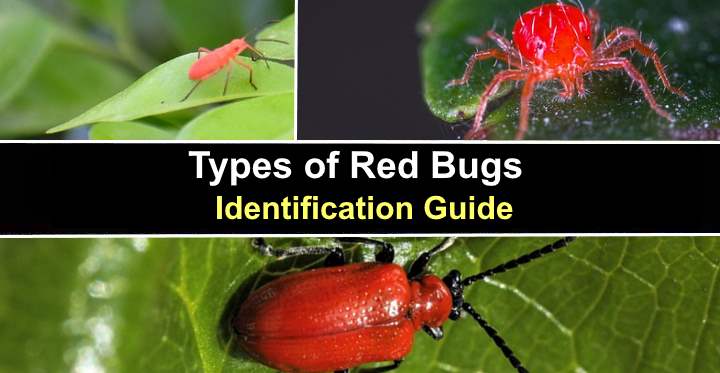
Tiny red bugs in the house can be annoying creatures because some bite and others leave a red stain if you squash them. The most common small bugs with red bodies are chiggers and red clover mites. These almost microscopic reddish-brown bugs can be hard to spot. Other red bugs you could find in your home are red spider mites, red scarlet beetles, or black and red boxelder bugs.
Sometimes the only time you know that red bugs have invaded your home is red bite marks or welts on your skin. However, during the fall, a large number of tiny red bugs and mites could enter homes looking for shelter. The first signs of these bugs are reddish stains that are easily confused for blood marks caused by bed bugs or other blood-sucking pests.
Suppose you have noticed tiny red creatures lurking in dark places. In that case, identifying the bugs is vital to know how to get rid of them. Additionally, it’s good to know if the red insects are dangerous or carry diseases.
This article is a guide to identifying red bugs you are likely to find in your home. In some cases, the bugs are so tiny that close-up pictures are required to see all their identifiable features. In addition, you will also get helpful tips on getting rid of red bugs.
What Are Red Bugs?
Red bugs can be species of beetles, mites, arachnids, or insects. Some red bugs are so tiny that you need a magnifying glass to see them. Other red insects like the scarlet lily beetle have brightly-colored red bodies and are easily recognizable. Red bugs range in size from 0.01” to 0.35” (0.4 – 9 mm) long.
Most red bugs in homes are so tiny you can’t see them with the naked eye. For example, chiggers are red mites that cause the most suffering to humans. However, these little red tick-like nuisances measure 0.01” (0.4 mm). Similarly, harmless red clover mites are around 0.03” (0.75 mm) long.
Most red bugs or mites have oval, tear-shaped bodies and six or eight legs, depending on if it’s an insect or arachnid. However, because the microscopic bugs are so tiny, you will have difficulty identifying them at home without a powerful hand lens.
Although most people refer to tiny red nuisance pests as red bugs, not all these creatures are bugs in the true scientific sense. The only true red bug in this list is the boxelder bug in the insect order Hemiptera. In addition, only the nymphs are bright red, whereas the adults are black and red bugs.
Red clover mites, chiggers (berry bugs), scarlet lily beetles, and spider mites are not classified as red insects but creatures in the phylum Arthropoda. However, people refer to them as red bugs because of the nuisance aspect.
Types of Tiny Red Bugs (Overview)
This article is a guide to five of the most common red bugs you will encounter indoors and outdoors — red clover mites, red berry bugs, red spider mites, scarlet lily beetles, and boxelder bugs. From these bugs, the only ones you are likely to identify with the naked eye are scarlet lily beetles and boxelder bugs.
Types of Red Bugs (with Pictures) — Identification Guide
Let’s look in detail at various kinds of red insects, mites, and arthropods you might come across in your home or yard.
Red Clover Mites (Bryobia praetiosa)

A close up picture of a red clover mite
Red clover mites are tiny plant-feeding mites that can become a pest indoors. The tiny red bug has a red or reddish-brown, oval-shaped body and eight legs. An identifying feature of the clover mite is its extended front legs that look like a pair of antennae. The red mites are 0.03” – 0.033” (0.75 – 0.85 mm) long.
Clover mites are tiny, almost microscopic red bugs that feed on plants in the yard. Masses of red bugs can become a pest indoors after heavy rainfall or excessive summer heat. They also tend to invade homes in spring or when the weather becomes cooler.
You may notice red clover mites crawling around doors, windows, and walls. Although red clover mites are identified as having a round body and eight legs, they only appear as tiny reddish or brownish dots or pinpricks moving around. Signs of red clover mites could be reddish stains when they’ve been squashed. These marks aren’t blood but red pigment from the mites’ bodies.
In the garden, you will often find red clover mites on ornamental flowers, dandelion, daffodils, primrose, and various lawn grasses. Red clover mite damage appears as tiny silvery streaks on leaves. Large populations of red-colored mites can cause brown patches to appear in lawns.
Red clover mites are usually attracted into homes when there is a temperature change outside or heavy rain. Also, many bugs like red clover mites are attracted to moisture. Typically, if you have vegetation close to your foundations, you run the risk of attracting a wide variety of pests into your home.
The only real damage red clover mites do indoors is to leave behind characteristic red stains. The red marks on carpets, bedding, or soft upholstery cause many people to mistake them for other small brown bugs like bed bugs or ticks. However, red clover mites don’t bite humans or suck blood.
Tiny red bug identification
Red clover mites look like tiny dark red or brown period marks moving around walls, doors, and windows. Under a microscope, the reddish-brown mite is identified by its reddish oval body, feather-like plates on its abdomen, and eight legs, two of which extend forward at the front.
How to get rid of tiny red clover mites
The best way to get rid of tiny red clover mites is to prevent them from entering your home. To avoid a red bug invasion, remove mulch, grass, and plants from your house’s perimeter. You will need to create a 2 ft. (60 cm) gap between the building and plant life.
To get rid of red clover mites from inside your house, use a vacuum cleaner to suck them up. This will prevent squashing them and staining drapes, carpets, or upholstery. After vacuuming the pesky red bugs, destroy the dust bag or empty it far away from your house.
At the same time, it’s vital to seal up tiny cracks in the foundations, around windows, doors, and where pipes enter buildings.
Berry Bugs / Chiggers (Trombicula)
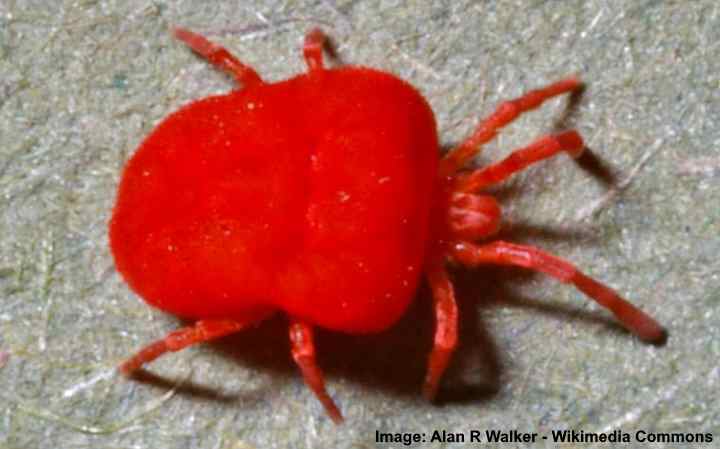
A close up image of a berry bug / chigger (Trombicula autumnalis)
Chiggers are incredibly tiny red bugs that can bite, causing swollen welts that are irritatingly itchy. Berry bugs or chiggers have a red, oval body, six legs, and are microscopic. Usually, the only way to identify this tiny red arachnid is by the pimple-like itchy bumps that look and feel like a severely itchy skin rash.
Chiggers also go by the names berry bugs, scrub-itch mites, harvest lice, harvest bugs, mower’s mites, or simply — red bugs. These tiny red creatures aren’t insects; instead, they are in the same family as ticks and spiders.
Chiggers don’t grow larger than 0.01” (0.4 mm) long. Like all arachnids, chiggers have eight legs. The little red bugs are almost impossible to see with the naked eye. But under a microscope, you will notice they have an oval, bulbous body and a small head. Their red color is their body color, not because they have had a blood meal.
The life cycle of a chigger starts as an egg that a female lays in leaf litter on the ground. When it hatches, an immature chigger has a bright red body and six legs. The larvae then look for a host to have a blood meal and begin feeding. After one complete meal, the microscopic red bugs molt into eight-legged adults.
Chiggers are usually found in grassy or bushy areas where they are active in the afternoons. You might get problems with chigger bites when walking in grassy areas during late spring through early fall.
Do chiggers bite? Adult chiggers don’t bite, but their larvae will attach themselves to a host and use their sharp jaws to inflict a bite and inject saliva. This usually results in an itchy, swollen welt that can last for several days. In some circumstances, the rash will appear and itch for a couple of weeks.
To spot chiggers on your skin, check yourself over after being outdoors. You may see tiny red dots scurrying over your skin. If you spot signs of chiggers, take a shower and thoroughly wash with soap and water. It’s then vital to wash your clothing in hot water to kill any red bugs lurking there.
Tiny red bug identification
Chiggers are usually identified by the bite marks on the skin — red itchy welts. Adult chiggers have a bright red body and eight legs. The tiny bugs only measure 0.01” (0.4 mm), and the minuscule larvae — the biting chiggers — only measure 0.0066” (0.17 mm).
How to get rid of tiny red bugs
If you have been outdoors where you suspect chiggers live, you should wash thoroughly when back indoors. Likewise, you should wash any clothing you had on. This is usually enough to kill any nasty bugs you inadvertently brought home.
Thankfully, chiggers seldom cause problems in the home as they don’t survive long indoors. However, if you suspect some nasty red bugs are causing a problem, remove them with a vacuum cleaner and wipe down all surfaces with a natural disinfecting solution.
Tiny Red Spider Mites (Tetranychus urticae)

Red spider mites on a leaf underside
Red spider mites look like tiny red bugs crawling on plants or webbing under plant leaves. The tiny red spider mites are only 0.016” (0.4 mm) long. Close-up pictures of the red bugs show they have an oval body and eight spiny legs.
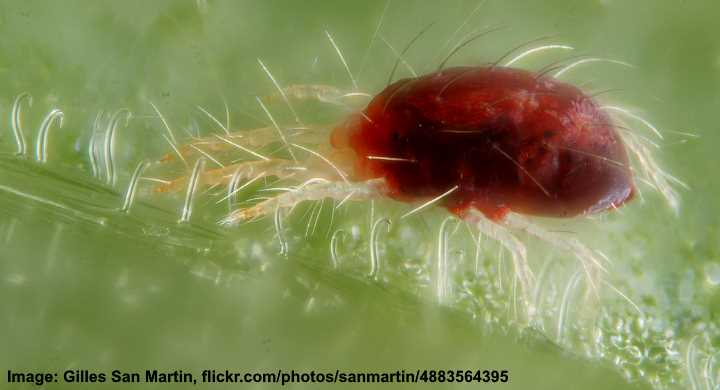
A close up picture of a red spider mite
Spider mites usually do a lot of damage to house plants. The tiny red pests use their piercing jaws to bite plant tissue and suck the juices from foliage and stems. This destructive behavior can cause leaves to turn yellow, develop spots, wither, and eventually die.
Red spider mites are notoriously challenging to identify on plants. The red creatures are so minute that you can hardly see them without a magnifying glass. The first sign of a spider mite infestation is usually webbing or strands of silky thread under leaves.
Red spider mites can infest many varieties of houseplants, as well as vegetable crops, fruit bushes, fruit trees, and citrus trees. They can also be plant-destroying pests in greenhouses, where they feed on tomato, eggplants, and cucumber plants.
Tiny red bug identification
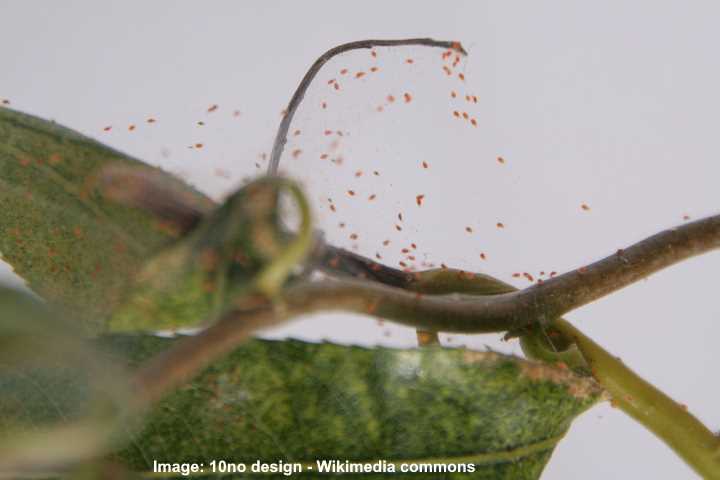
A picture showing red spider mites on a plant – the spider mites are the tiny red bugs on the sticky webs
To identify red spider mites, look for signs of webbing under leaves and between stems and leaves. Even a few thin strands of silky web are enough to confirm spider mites are present. You can also identify the red mites by putting white paper under the foliage and tapping on the leaves to see if any drop.
Suppose a red spider mite infestation is severe. In that case, you will notice yellow leaves, leaf spots, brown patches on flowers, and premature leaf drop.
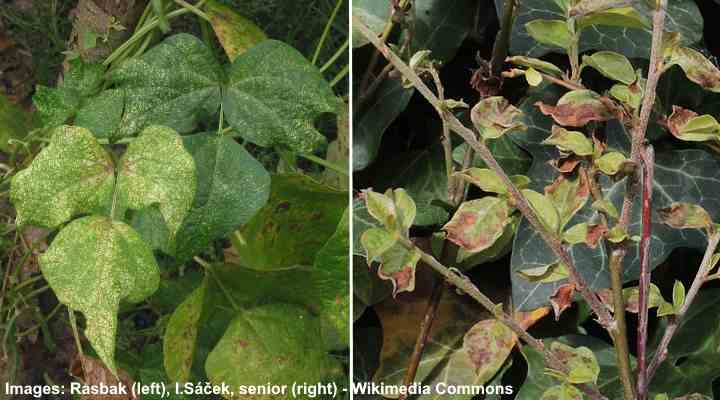
Leaf damage caused by spider mites
If you are unsure about the presence of spider mites, use a 10x or 15x hand lens to identify the red bugs. You will notice red dots like pinpricks moving under leaves and along the webbing. Little white or greenish dots could be signs of other types of spider mites.
How to get rid of tiny red spider mites
The best way to eradicate red spider mites from houseplants or ornamental garden shrubs is to use neem oil.
Make a DIY neem oil solution by combining 2 tsp. organic neem oil and 1 tsp. Castile soap with 1 quart (1 l) of warm water. Pour the natural insecticide in a spray bottle and liberally spray both sides of the leaves to eliminate spider mites.
For best results, reapply the neem oil every seven days, allowing the solution to dry on the leaves.
Another natural spray for getting rid of red spider mites is to make a 1:1 rubbing alcohol and water spray. Use the alcohol spray on leaves and wipe clean to eliminate all plant bugs.
Suppose you notice red spider mites on garden plants. In that case, you can also turn the garden hose on the foliage. Use short sharp bursts of water to dislodge the spider mites and any other bugs from plant foliage.
Red Lily Beetle / Red Scarlet Beetle (Lilioceris lilii)
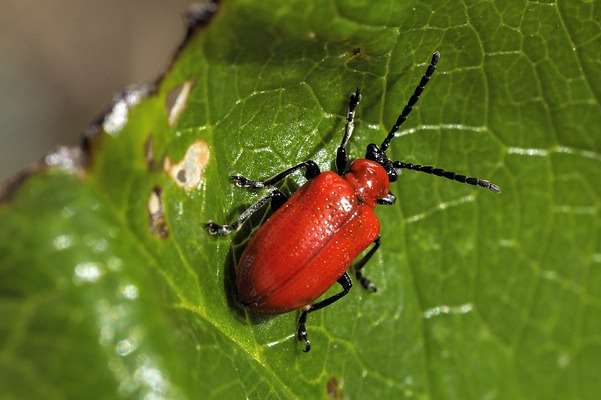
The scarlet lily beetle is a bright red flying bug with black legs and black antennae
The scarlet lily beetle is a brightly-colored red beetle that feeds on lily leaves, stems, buds, and flowers. The bright red beetles measure 0.25” to 0.35” (6 to 9 mm) long. They have a scarlet red body and thorax. But they have a black head, relatively long legs, and two antennae.
The red and black beetles can do tremendous foliage and flower damage to plants in the Lilium and Fritillaria species. The first sign of red beetle damage is usually holes appearing in lily leaves. However, you may notice sticky brown frass (excrement) piles on leaves.
In time, the plant-destroying beetles can defoliate an entire plant.
An effective way to get rid of red lily beetles is to handpick them from plants. First, if you notice frass piles, it’s vital to wipe them clean with a rubbing alcohol solution because these contain the larvae. Then if you see red and black beetles on plants, pick them off and drop them in a bucket of soapy water.
Neem oil can also effectively eradicate red scarlet beetle larvae and adults from lily plants. Apply the neem oil solution to all the plant’s foliage every five to seven days after the larvae hatch.
Red bug identification
The red lily scarlet beetle is identified by its bright, scarlet-red oval body and thorax. You will also notice six jet-black legs, two black antennae made up of 11 segments, and a small black head. The red and black bugs are often seen on lily plants.
Boxelder Bug (Boisea trivittata)
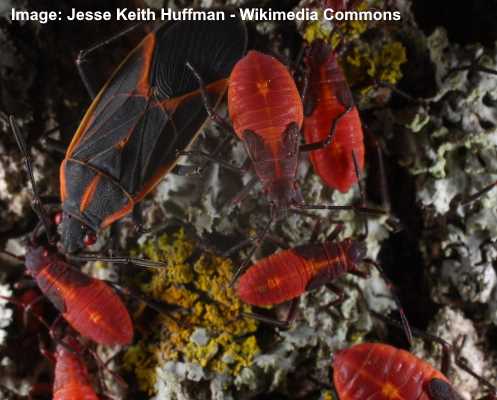
Adult and nymph boxelder bugs
Boxelder bugs are red and black winged bugs with six black legs and two long, arching antennae. Although the bug looks more black or brown than red, it’s the nymphs that are bright red.
The red immature bugs are an elongated oval shape and take 50 to 78 days to reach maturity. The red bugs molt five times, and it’s halfway through their nymphal stage that they lose the characteristic bright red coloring and become more dark-brownish to black.
Adult boxelder bugs fly between trees and are commonly found on boxelder trees, ash trees, and maple trees.
These small red pests enter buildings in summer through open windows, doors, or cracks in the siding or foundation. You may see masses of them near cracks as they clamber to get into a house.
The best way to get rid of boxelder bugs is to prevent them from getting into your home. For example, window or door screens can stop the red and black bug flying into your home. Also, caulking cracks around windows and in walls will help keep all insects out. If you see groups of boxelders on the sides of your house, you can spray them with insecticidal soap or hot soapy water to dislodge and kill them.
Related articles:
- Small Brown Bugs – Identification Guide With Pictures
- Types of Green Insects – Identification Guide
- Small Black Bugs – Identification Guide
